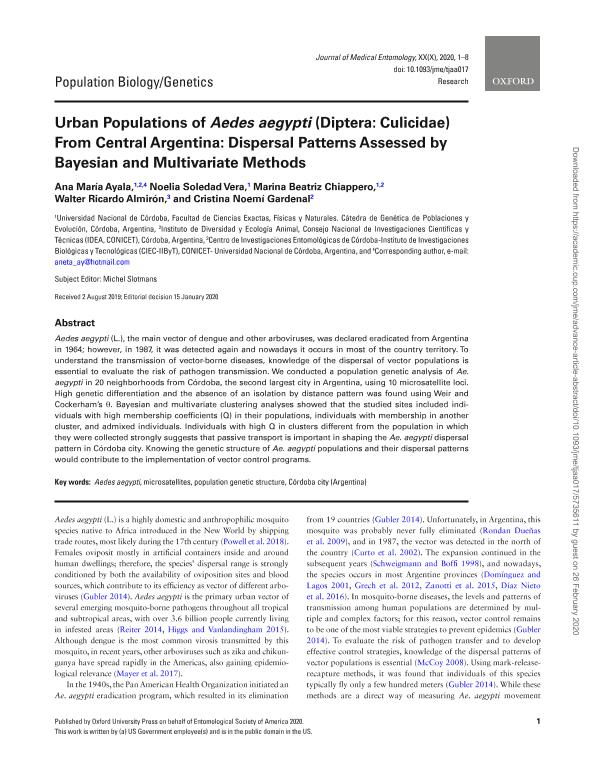Artículo
Urban populations of Aedes aegypti (Diptera: Culicidae) from Central Argentina: Dispersal patterns assessed by bayesian and multivariate methods
Ayala, Ana Maria ; Vera, Noelia Soledad
; Vera, Noelia Soledad ; Chiappero, Marina Beatriz
; Chiappero, Marina Beatriz ; Almiron, Walter Ricardo
; Almiron, Walter Ricardo ; Gardenal, Cristina Noemí
; Gardenal, Cristina Noemí
 ; Vera, Noelia Soledad
; Vera, Noelia Soledad ; Chiappero, Marina Beatriz
; Chiappero, Marina Beatriz ; Almiron, Walter Ricardo
; Almiron, Walter Ricardo ; Gardenal, Cristina Noemí
; Gardenal, Cristina Noemí
Fecha de publicación:
07/2020
Editorial:
Entomological Society of America
Revista:
Journal of Medical Entomology
ISSN:
0022-2585
e-ISSN:
1938-2928
Idioma:
Inglés
Tipo de recurso:
Artículo publicado
Clasificación temática:
Resumen
Aedes aegypti (L.), the main vector of dengue and other arboviruses, was declared eradicated from Argentinain 1964; however, in 1987, it was detected again and nowadays it occurs in most of the country territory. Tounderstand the transmission of vector-borne diseases, knowledge of the dispersal of vector populations isessential to evaluate the risk of pathogen transmission. We conducted a population genetic analysis of Ae.aegypti in 20 neighborhoods from C¨®rdoba, the second largest city in Argentina, using 10 microsatellite loci.High genetic differentiation and the absence of an isolation by distance pattern was found using Weir andCockerham¡¯s ¦È. Bayesian and multivariate clustering analyses showed that the studied sites included individualswith high membership coefficients (Q) in their populations, individuals with membership in anothercluster, and admixed individuals. Individuals with high Q in clusters different from the population in whichthey were collected strongly suggests that passive transport is important in shaping the Ae. aegypti dispersalpattern in Córdoba city. Knowing the genetic structure of Ae. aegypti populations and their dispersal patternswould contribute to the implementation of vector control programs.
Palabras clave:
AEDES
,
AEGYPTI
,
POBLACIONES
,
CORDOBA
Archivos asociados
Licencia
Identificadores
Colecciones
Articulos(IDEA)
Articulos de INSTITUTO DE DIVERSIDAD Y ECOLOGIA ANIMAL
Articulos de INSTITUTO DE DIVERSIDAD Y ECOLOGIA ANIMAL
Articulos(IIBYT)
Articulos de INSTITUTO DE INVESTIGACIONES BIOLOGICAS Y TECNOLOGICAS
Articulos de INSTITUTO DE INVESTIGACIONES BIOLOGICAS Y TECNOLOGICAS
Citación
Ayala, Ana Maria; Vera, Noelia Soledad; Chiappero, Marina Beatriz; Almiron, Walter Ricardo; Gardenal, Cristina Noemí; Urban populations of Aedes aegypti (Diptera: Culicidae) from Central Argentina: Dispersal patterns assessed by bayesian and multivariate methods; Entomological Society of America; Journal of Medical Entomology; 57; 4; 7-2020; 1069-1076
Compartir
Altmétricas



